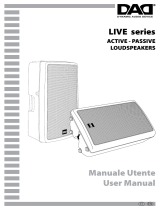
The acoustic characteristics of the room/environment in which a sound system is used have
sometimes very significant effects on the overall sound produced.
Thanks to its special technical features (such as the optimal width of its dispersion range),
with the VERSE D:SUB some of the most common problems can be reduced or prevented.
However, some factors should be borne in mind as they may help to optimise its
performance.
• Do not place speakers in the corners of a room or in recesses (e.g. niches), since this
causes an increase in the low frequencies, producing sounds which are redundant or
blurred.
• Do not place speakers against a wall, as this also causes an increase in the low frequencies,
although less pronounced than that produced in a corner or niche.
N.B.: on the other hand, this phenomenon may sometimes be used to advantage to
reinforce the low range, but it must be employed carefully and in a controlled way.
• Do not place speakers straight on a stage, a floating floor or any other support with
cavities, as this tends to trigger resonances that alter and interfere with the overall sound.
N.B.: solid supports should always be used when possible, or a speaker stand.
• Remember that high frequencies have a high level of directivity and a much higher
absorption coefficient than low frequencies. Therefore, to guarantee that the signal
reaches the listener in an intelligible form, position speakers so that they are in a direct
line with the audience (clearly visible) about ½ metre / 1 metre above the audience’s heads.
• In buildings with a lot of reverberation (places of worship, gymnasiums, etc.) first of all
keep the sound reflections down using materials which absorb sound (carpets, curtains,
special panels, etc.). If this is not possible or is not sufficient, do not simply turn up the
volume, because this will also increase the volume of the reflected sound, and may make
the situation even worse. The best solution is to use more speakers, placed around the
room and closer to the audience (e.g. front+back; front+sides; front+sides+back).
N.B.: in these circumstances it may prove necessary to use the integrated delay line
provided with the D:SUB internal DSP processor realign the timing of the sound of the
various speakers (i.e. to overcome the delays caused by the sound propagation time),
ensuring that the sound heard by the audience will be free from “echo”.
Example: since the speed of sound is about 344 metres a second, sound takes about 1/10
of a second to travel 30 metres. Therefore, a listener close to a “back” speaker 30 metres
from the “front” speaker would hear the sound from the “back” speaker about 1/10 of a
second before the sound from the “front” speaker: in other words, he would hear two
identical sounds 1/10 of a second apart. To ensure that the two sounds strike the ear of
this specific listener at exactly the same time, the sound of the “back” speaker will have to
be delayed by 1/10 of a second using the D:SUB Delay line.





















